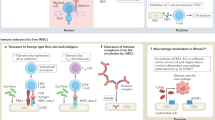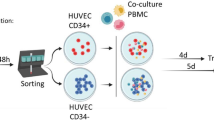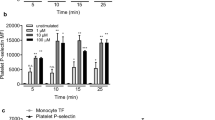Abstract
Clinical use of G-CSF can result in vascular and inflammatory complications1,2,3,4,5,6,7. To investigate the molecular basis of these effects, we analyzed the adherence of G-CSF–mobilized human peripheral blood leukocytes (ML) to inflamed (TNF-α–stimulated) vascular endothelium. Studies using parallel plate assays under physiologic flow conditions and intravital microscopy in a mouse inflammation model each showed that ML take part in heightened adhesive interactions with endothelium compared to unmobilized (native) blood leukocytes, mediated by markedly increased E-selectin receptor-ligand interactions. Biochemical studies showed that ML express the potent E-selectin ligand HCELL (ref. 8) and another, previously unrecognized ∼65-kDa E-selectin ligand, and possess enhanced levels of transcripts encoding glycosyltransferases (ST3GalIV, FucT-IV and FucT-VII) conferring glycan modifications associated with E-selectin ligand activity. Enzymatic treatments and physiologic binding assays showed that HCELL and the ∼65-kDa E-selectin ligand contribute prominently to the observed G-CSF–induced myeloid cell adhesion to inflamed endothelium. Treatment of normal human bone marrow cells with a pharmacokinetically relevant concentration of G-CSF in vitro9,10 resulted in increased expression of these two molecules, coincident with increased transcripts encoding pertinent glycosyltransferases and heightened E-selectin binding. These findings provide direct evidence for a role of G-CSF in the induction of E-selectin ligands on myeloid cells, thus providing mechanistic insight into the pathobiology of G-CSF complications.
This is a preview of subscription content, access via your institution
Access options
Subscribe to this journal
Receive 12 print issues and online access
$209.00 per year
only $17.42 per issue
Buy this article
- Purchase on Springer Link
- Instant access to full article PDF
Prices may be subject to local taxes which are calculated during checkout




Similar content being viewed by others
References
Lindemann, A. & Rumberger, B. Vascular complications in patients treated with granulocyte colony-stimulating factor (G-CSF). Eur. J. Cancer 29A, 2338–2339 (1993).
Hill, J.M. et al. Outcomes and risks of granulocyte colony-stimulating factor in patients with coronary artery disease. J. Am. Coll. Cardiol. 46, 1643–1648 (2005).
Arimura, K. et al. Acute lung injury in a healthy donor during mobilization of peripheral blood stem cells using granulocyte-colony stimulating factor alone. Haematologica 90, ECR10 (2005).
Fukumoto, Y. et al. Angina pectoris occurring during granulocyte colony-stimulating factor-combined preparatory regimen for autologous peripheral blood stem cell transplantation in a patient with acute myelogenous leukaemia. Br. J. Haematol. 97, 666–668 (1997).
Dereure, O., Hillaire-Buys, D. & Guilhou, J.J. Neutrophil-dependent cutaneous side-effects of leucocyte colony-stimulating factors: manifestations of a neutrophil recovery syndrome? Br. J. Dermatol. 150, 1228–1230 (2004).
Stricker, R.B. & Goldberg, B. G-CSF and exacerbation of rheumatoid arthritis. Am. J. Med. 100, 665–666 (1996).
Adler, B.K. et al. Fatal sickle cell crisis after granulocyte colony-stimulating factor administration. Blood 97, 3313–3314 (2001).
Dimitroff, C.J., Lee, J.Y., Rafii, S., Fuhlbrigge, R.C. & Sackstein, R. CD44 is a major E-selectin ligand on human hematopoietic progenitor cells. J. Cell Biol. 153, 1277–1286 (2001).
van Der Auwera, P. et al. Pharmacodynamics and pharmacokinetics of single doses of subcutaneous pegylated human G-CSF mutant (Ro 25–8315) in healthy volunteers: comparison with single and multiple daily doses of filgrastim. Am. J. Hematol. 66, 245–251 (2001).
Faulkner, L.B. et al. G-CSF serum pharmacokinetics during peripheral blood progenitor cell mobilization: neutrophil count-adjusted dosage might potentially improve mobilization and be more cost-effective. Bone Marrow Transplant. 21, 1091–1095 (1998).
Elfenbein, G.J. & Sackstein, R. Primed marrow for autologous and allogeneic transplantation: a review comparing primed marrow to mobilized blood and steady-state marrow. Exp. Hematol. 32, 327–339 (2004).
Sackstein, R. The lymphocyte homing receptors: gatekeepers of the multistep paradigm. Curr. Opin. Hematol. 12, 444–450 (2005).
Kansas, G.S. Selectins and their ligands: current concepts and controversies. Blood 88, 3259–3287 (1996).
Albert, R.K. Mechanisms of the adult respiratory distress syndrome: selectins. Thorax 50 (suppl. 1), S49–S52 (1995).
Kriegsmann, J. et al. Expression of E-selectin messenger RNA and protein in rheumatoid arthritis. Arthritis Rheum. 38, 750–754 (1995).
Glass, L.F., Fotopoulos, T. & Messina, J.L. A generalized cutaneous reaction induced by granulocyte colony-stimulating factor. J. Am. Acad. Dermatol. 34, 455–459 (1996).
Bussolino, F. et al. Granulocyte- and granulocyte-macrophage-colony stimulating factors induce human endothelial cells to migrate and proliferate. Nature 337, 471–473 (1989).
Fuste, B. et al. Granulocyte colony-stimulating factor increases expression of adhesion receptors on endothelial cells through activation of p38 MAPK. Haematologica 89, 578–585 (2004).
Sipkins, D.A. et al. In vivo imaging of specialized bone marrow endothelial microdomains for tumour engraftment. Nature 435, 969–973 (2005).
Smith, M.L., Olson, T.S. & Ley, K. CXCR2- and E-selectin-induced neutrophil arrest during inflammation in vivo. J. Exp. Med. 200, 935–939 (2004).
Kieffer, J.D. et al. Neutrophils, monocytes, and dendritic cells express the same specialized form of PSGL-1 as do skin-homing memory T cells: cutaneous lymphocyte antigen. Biochem. Biophys. Res. Commun. 285, 577–587 (2001).
Fuhlbrigge, R.C., King, S.L., Dimitroff, C.J., Kupper, T.S. & Sackstein, R. Direct real-time observation of E- and P-selectin-mediated rolling on cutaneous lymphocyte-associated antigen immobilized on western blots. J. Immunol. 168, 5645–5651 (2002).
Zollner, O. et al. L-selectin from human, but not from mouse neutrophils binds directly to E-selectin. J. Cell Biol. 136, 707–716 (1997).
Ohsaka, A. et al. Granulocyte colony-stimulating factor down-regulates the surface expression of the human leucocyte adhesion molecule-1 on human neutrophils in vitro and in vivo. Br. J. Haematol. 84, 574–580 (1993).
Wagers, A.J., Waters, C.M., Stoolman, L.M. & Kansas, G.S. Interleukin 12 and interleukin 4 control T cell adhesion to endothelial selectins through opposite effects on alpha1, 3-fucosyltransferase VII gene expression. J. Exp. Med. 188, 2225–2231 (1998).
Hakansson, L. et al. Effects of in vivo administration of G-CSF on neutrophil and eosinophil adhesion. Br. J. Haematol. 98, 603–611 (1997).
Jilma, B. et al. Rapid down modulation of P-selectin glycoprotein ligand-1 (PSGL-1, CD162) by G-CSF in humans. Transfusion 42, 328–333 (2002).
Xia, L. et al. P-selectin glycoprotein ligand-1-deficient mice have impaired leukocyte tethering to E-selectin under flow. J. Clin. Invest. 109, 939–950 (2002).
Cowland, J.B. & Borregaard, N. Isolation of neutrophil precursors from bone marrow for biochemical and transcriptional analysis. J. Immunol. Methods 232, 191–200 (1999).
Zou, X. et al. PSGL-1 derived from human neutrophils is a high-efficiency ligand for endothelium-expressed E-selectin under flow. Am J. Physiol. Cell Physiol. 289, C415–C424 (2005).
Acknowledgements
We are grateful to the staff at the Cell Manipulation Core Facility of Dana Farber Cancer Center for their assistance in procuring G-CSF–mobilized peripheral blood pheresis products and to the staff of the Cell Processing Laboratory of the Bone Marrow Transplantation Unit at the Massachusetts General Hospital for their assistance in procuring the bone marrow material. This work was supported by US National Institutes of Health grants RO1 HL060528 (R.S.), RO1 HL073714 (R.S.), the Team Jobie Leukemia Research Fund (R.S.) and RO1 EB000664 and Wellman Center Advanced Microscopy startup fund (C.P.L.).
Author information
Authors and Affiliations
Contributions
N.M.D. designed the research, performed experiments, analyzed data and wrote the paper; S.Z.G. performed RT-PCR; C.A.K. provided technical assistance; J.A.S. and P.Z. performed intravital microscopy and analyzed data; C.P.L. oversaw intravital microscopy experiments and partially provided funding for the research; R.S. designed research, analyzed data, wrote the paper, provided funding for the research and supervised all experimentation.
Corresponding author
Ethics declarations
Competing interests
The authors declare no competing financial interests.
Supplementary information
Supplementary Fig. 1
mAbs specific to L-selectin, CD29 or CD18 have no effect on primary tethering of ML on stimulated HUVECs and there are no distinct differences in the surface expression of integrin-type homing receptors LFA-1 (CD11a/CD18; αLβ2) and VLA-4 (CD49d/CD29; α4β1) and chemokine receptor CXCR4 on ML and NL. (PDF 840 kb)
Supplementary Fig. 2
HECA-452–reactive glycoproteins of ML are sensitive to sialidase treatment. (PDF 259 kb)
Supplementary Fig. 3
E-Ig-reactive glycoproteins of ML do not stain in the presence of EDTA or with control human immunoglobulin. (PDF 270 kb)
Supplementary Fig. 4
HECA-452–reactive ∼65 kDa E-selectin ligand does not appear to be related to PSGL-1 or CD44. (PDF 328 kb)
Supplementary Fig. 5
G-CSF treatment significantly enhances the capability of human BM cells to adhere to endothelial E-selectin under physiologic flow conditions. (PDF 330 kb)
Supplementary Fig. 6
HCELL and ∼65 kDa glycoprotein are major E-selectin ligands on ML. (PDF 803 kb)
Supplementary Video 1
This movie shows ML interacting with vascular endothelium within the TNF-α–treated ear. Note the prominent presence of stable rolling interactions. (MOV 2133 kb)
Supplementary Video 2
This movie shows NL interacting with vascular endothelium within the TNF-α–treated ear. Compared to ML (Supplementary Video 1), NL display transient and faster rolling interactions. (MOV 2959 kb)
Rights and permissions
About this article
Cite this article
Dagia, N., Gadhoum, S., Knoblauch, C. et al. G-CSF induces E-selectin ligand expression on human myeloid cells. Nat Med 12, 1185–1190 (2006). https://doi.org/10.1038/nm1470
Received:
Accepted:
Published:
Issue Date:
DOI: https://doi.org/10.1038/nm1470
This article is cited by
-
Cyclic neutropenia and concomitant IgA nephropathy: a case report
BMC Nephrology (2023)
-
Endothelial E-selectin inhibition improves acute myeloid leukaemia therapy by disrupting vascular niche-mediated chemoresistance
Nature Communications (2020)
-
Exploiting metabolic glycoengineering to advance healthcare
Nature Reviews Chemistry (2019)
-
Development of membranoproliferative glomerulonephritis-like glomerulopathy in a patient with neutrophilia resulting from endogenous granulocyte-colony stimulating factor overproduction: a case report
BMC Nephrology (2018)
-
Identifying microRNA determinants of human myelopoiesis
Scientific Reports (2018)



